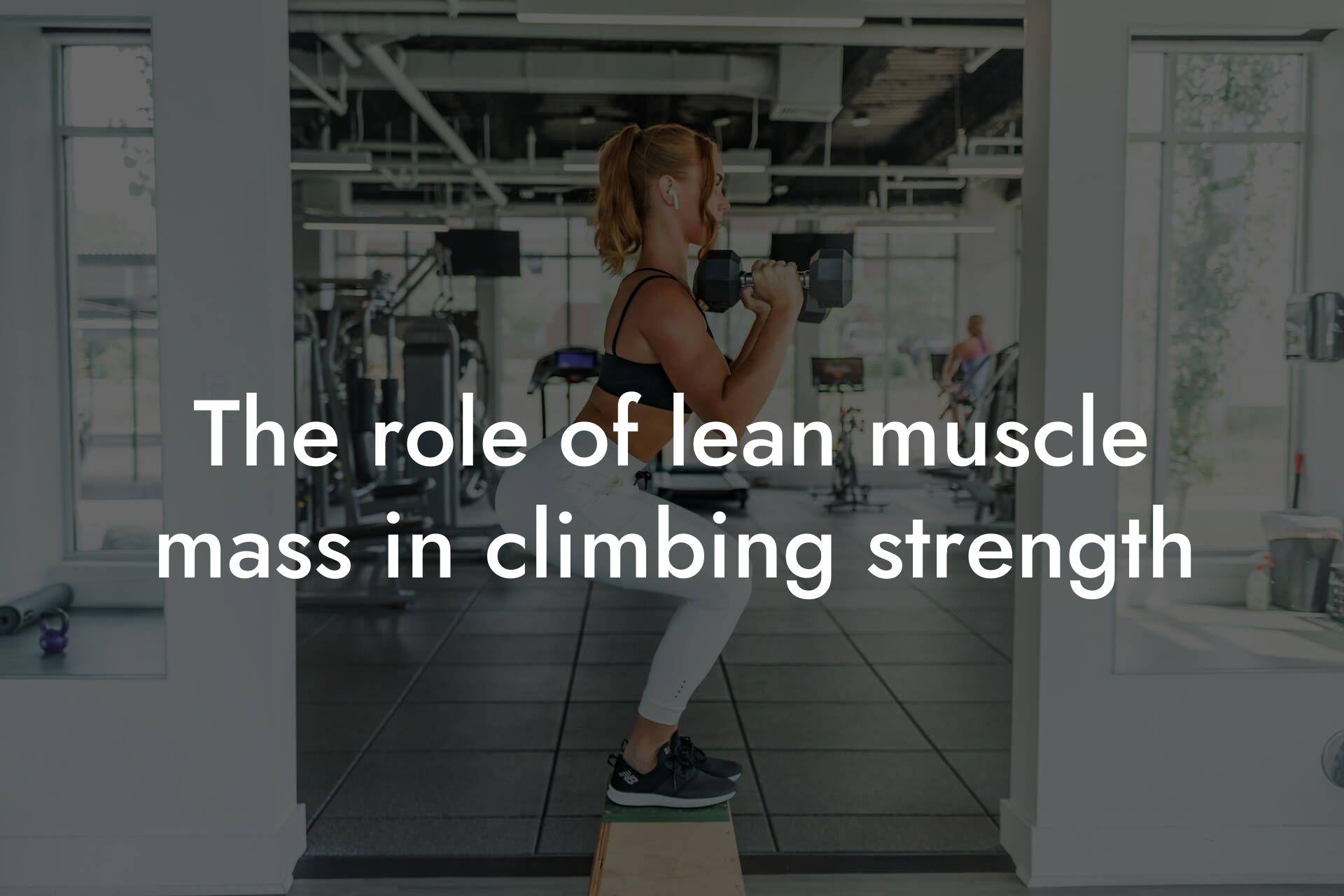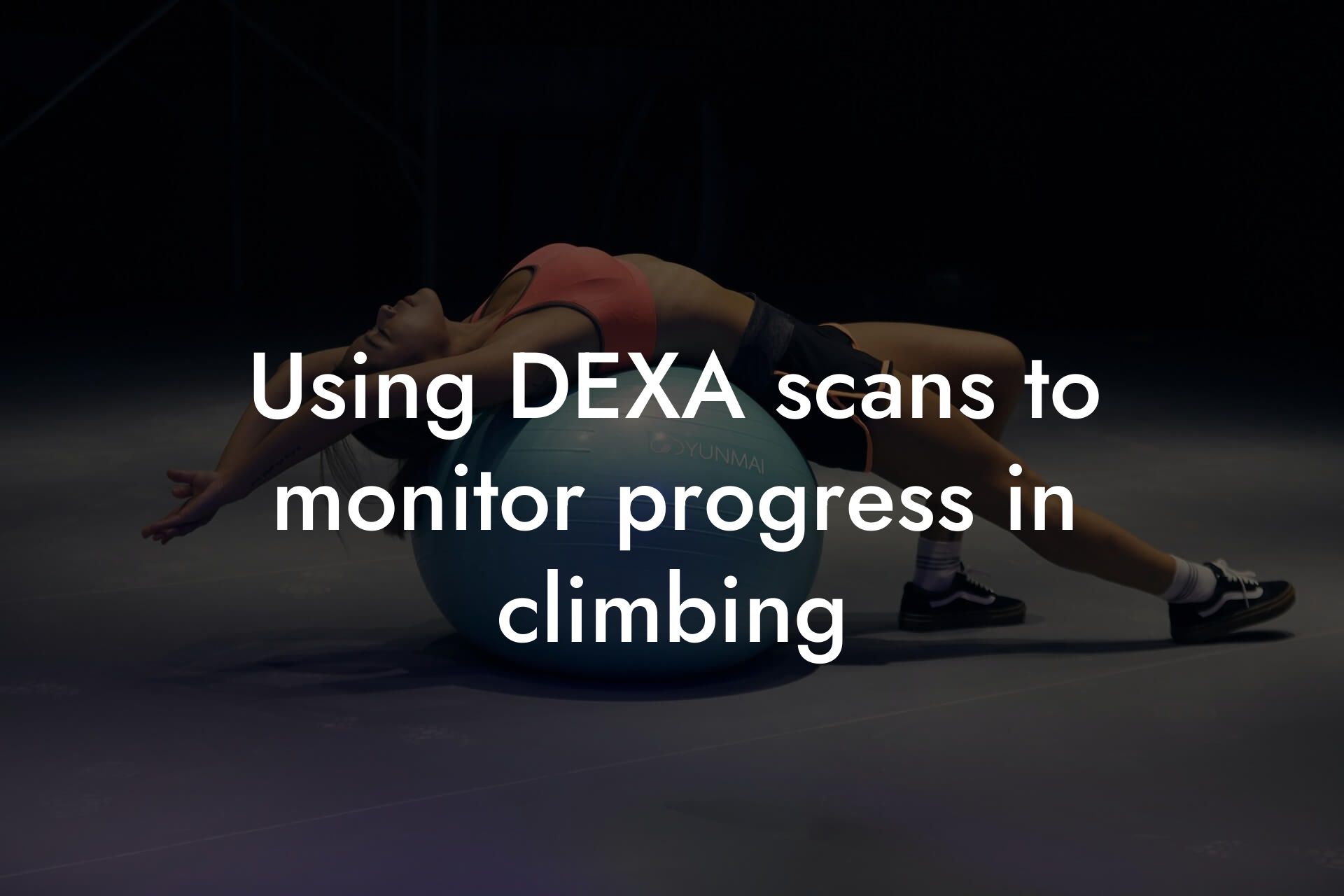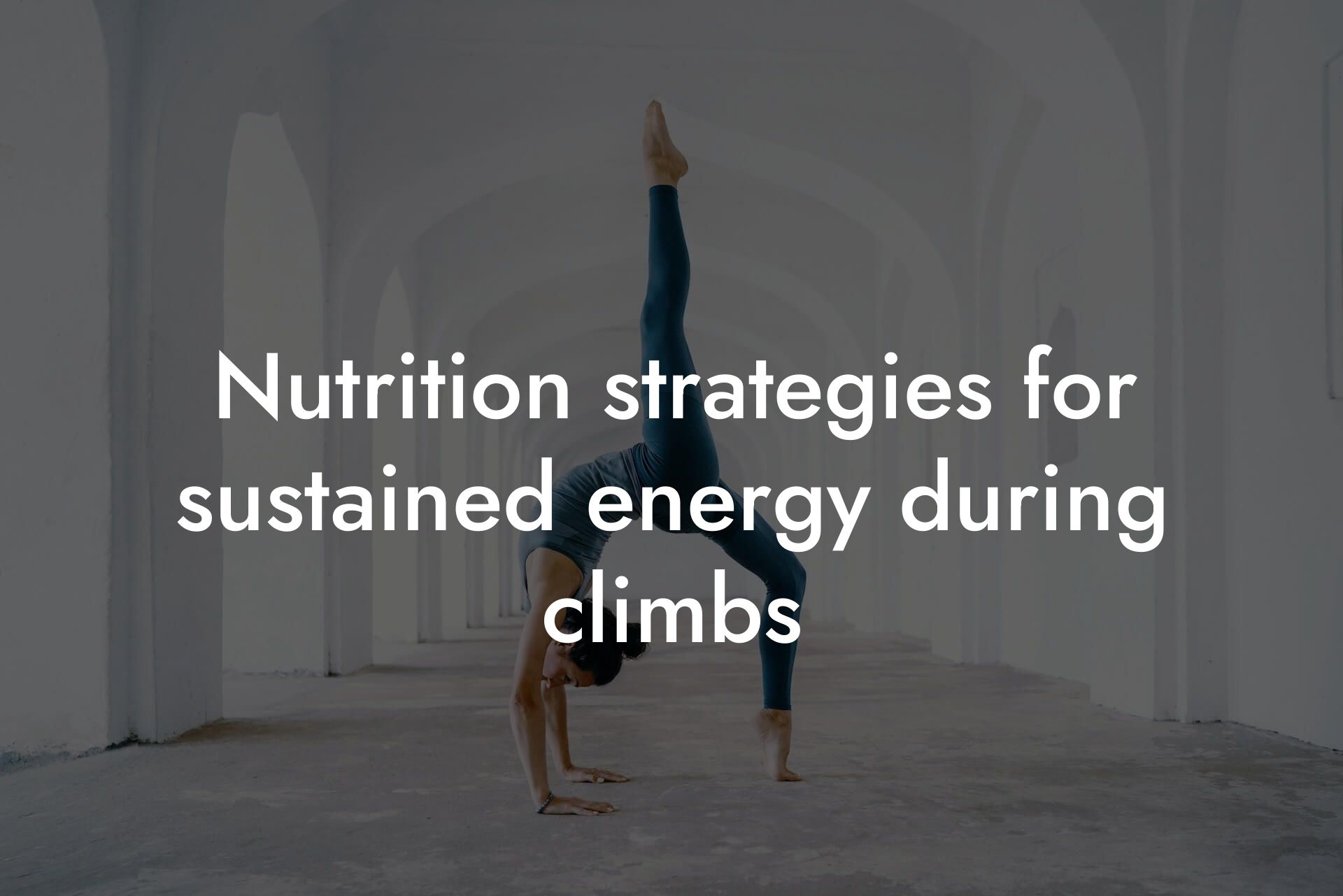As a climber, you're likely no stranger to the importance of physical fitness. But did you know that your body composition plays a critical role in your climbing performance? In this article, we'll dive into the relationship between body composition and climbing, exploring how factors like body fat percentage, lean mass, and bone density can affect your climbing abilities.
Table of Contents
- What is Body Composition?
- How Does Body Fat Affect Climbing Performance?
- The Importance of Lean Mass for Climbing
- Bone Density and Climbing Performance
- Optimizing Body Composition for Climbing
- Nutrition and Body Composition for Climbers
- Take Your Climbing to the Next Level with Tano Performance Group
- Frequently Asked Questions
What is Body Composition?
Body composition refers to the percentage of fat and lean mass in your body. Lean mass includes muscle, bone, and other non-fat tissues, while body fat is the amount of fat stored in your body. A healthy body composition is essential for overall health and athletic performance, including climbing. A DEXA scan, like the ones offered by Tano Performance Group, provides a comprehensive analysis of your body composition, giving you a detailed breakdown of your fat mass, lean mass, and bone density.
How Does Body Fat Affect Climbing Performance?
Excess body fat can significantly impact your climbing performance. Carrying extra weight can increase your energy expenditure, making it more difficult to climb efficiently. Additionally, excess fat can also affect your power-to-weight ratio, making it harder to generate the force needed to complete challenging climbs. Furthermore, high body fat percentages can also increase your risk of injury, as excess weight can put additional stress on your joints and muscles.
The Importance of Lean Mass for Climbing
Lean mass, on the other hand, is essential for climbing performance. Muscle mass, in particular, plays a critical role in generating power and force. Climbers with a higher percentage of lean mass tend to have an advantage when it comes to explosive movements and sustained efforts. Additionally, lean mass also helps to support bone density, which is crucial for climbers who need to absorb shock and withstand the forces of climbing.
Bone Density and Climbing Performance
Bone density is another critical component of body composition that affects climbing performance. Climbers with low bone density are at a higher risk of osteoporosis and fractures, which can be devastating for athletes who rely on their bodies to perform at a high level. A DEXA scan can provide valuable insights into your bone density, helping you identify areas for improvement and take proactive steps to maintain strong, healthy bones.
Optimizing Body Composition for Climbing
So, how can you optimize your body composition for climbing? The key is to focus on building lean mass while reducing body fat percentage. This can be achieved through a combination of proper nutrition, strength training, and cardiovascular exercise. A well-structured training program that includes exercises like squats, lunges, and deadlifts can help build the muscle mass needed for climbing. Additionally, incorporating high-intensity interval training (HIIT) can help improve your power-to-weight ratio and increase your overall climbing efficiency.
Nutrition and Body Composition for Climbers
Nutrition plays a critical role in body composition, and climbers need to fuel their bodies with the right foods to support their training and performance. A balanced diet that includes plenty of protein, complex carbohydrates, and healthy fats can help support muscle growth and recovery. Additionally, staying hydrated is essential for climbers, as even mild dehydration can negatively impact performance.
In conclusion, body composition plays a critical role in climbing performance. By understanding the importance of body fat percentage, lean mass, and bone density, climbers can take proactive steps to optimize their bodies for peak performance. A DEXA scan can provide valuable insights into your body composition, helping you identify areas for improvement and take your climbing to the next level. By focusing on building lean mass, reducing body fat percentage, and maintaining strong bones, you can unlock your full potential as a climber and reach new heights.
Take Your Climbing to the Next Level with Tano Performance Group
At Tano Performance Group, we understand the importance of body composition for climbers. Our DEXA scan technology provides a comprehensive analysis of your body composition, giving you the insights you need to optimize your training and nutrition. Whether you're a professional climber or just starting out, our team of experts can help you achieve your goals and take your climbing to the next level. Contact us today to learn more about how our services can help you unlock your full potential as a climber.
Frequently Asked Questions
What is body composition, and why is it important for climbing performance?
Body composition refers to the proportion of fat and lean mass in the body. For climbers, body composition is crucial as it affects power-to-weight ratio, endurance, and overall performance. A leaner body composition can improve climbing efficiency and reduce fatigue, while excess body fat can hinder performance and increase the risk of injury.
How does body fat percentage affect climbing performance?
Body fat percentage has a significant impact on climbing performance. Excess body fat can increase energy expenditure, reduce power output, and affect overall endurance. A higher body fat percentage can also increase the risk of injury, particularly in the shoulders, elbows, and fingers. On the other hand, a leaner body composition can improve climbing efficiency and reduce fatigue.
What is the ideal body fat percentage for climbers?
The ideal body fat percentage for climbers varies depending on the individual and their climbing goals. Generally, a body fat percentage between 10-15% for men and 15-20% for women is considered optimal for climbing performance. However, this can vary depending on factors such as age, muscle mass, and overall health.
How does muscle mass affect climbing performance?
Muscle mass plays a critical role in climbing performance. Having adequate muscle mass, particularly in the upper body, can improve power output, endurance, and overall climbing efficiency. Climbers with more muscle mass tend to have a higher power-to-weight ratio, which enables them to climb more efficiently and recover faster.
What is the relationship between bone density and climbing performance?
Bone density is an important factor in climbing performance, particularly for climbers who engage in high-impact activities such as bouldering or dynamic climbing. Low bone density can increase the risk of osteoporosis and fractures, which can be detrimental to climbing performance. Maintaining optimal bone density through a combination of diet, exercise, and supplementation can help improve climbing performance and reduce the risk of injury.
How can I measure my body composition?
There are several ways to measure body composition, including dual-energy X-ray absorptiometry (DXA), skinfold measurements, bioelectrical impedance analysis (BIA), and hydrostatic weighing. DXA is considered the most accurate method, but it may not be accessible to everyone. Skinfold measurements and BIA are more convenient and affordable options, but they may not be as accurate.
What is the best way to improve my body composition for climbing?
Improving body composition for climbing requires a combination of proper nutrition, consistent training, and sufficient recovery. Focus on consuming a balanced diet that is high in protein, moderate in carbohydrates, and low in fat. Engage in regular cardiovascular exercise, strength training, and flexibility exercises to improve overall fitness and muscle mass. Adequate sleep and recovery are also crucial for muscle growth and repair.
How can I reduce my body fat percentage for climbing?
Reducing body fat percentage for climbing requires a calorie-controlled diet, regular exercise, and patience. Focus on creating a calorie deficit by eating fewer calories than you burn, while ensuring you consume enough protein to support muscle growth and maintenance. Engage in regular cardiovascular exercise, such as cardio climbing or running, to burn excess fat. Strength training can also help improve muscle mass and increase metabolism.
What are the benefits of having a leaner body composition for climbing?
Having a leaner body composition can improve climbing performance in several ways. It can increase power-to-weight ratio, improve endurance, and reduce fatigue. A leaner body composition can also improve mental focus and confidence, reduce the risk of injury, and enhance overall climbing efficiency.
How does body composition affect climbing technique?
Body composition can affect climbing technique in several ways. A leaner body composition can improve flexibility, mobility, and range of motion, making it easier to execute complex climbing moves. Excess body fat can restrict movement and affect overall climbing technique, leading to poor form and increased risk of injury.
Can I improve my climbing performance without changing my body composition?
While body composition is an important factor in climbing performance, it is possible to improve performance without making significant changes to body composition. Focus on improving technique, building strength and endurance, and developing a more efficient climbing style. Mental preparation, route reading, and strategic climbing can also improve performance without requiring significant changes to body composition.
How does nutrition affect body composition for climbing?
Nutrition plays a critical role in body composition for climbing. A balanced diet that is high in protein, moderate in carbohydrates, and low in fat can support muscle growth and maintenance, while also promoting weight loss and improving body composition. Adequate hydration, electrolyte balance, and proper macronutrient ratios are also essential for optimal body composition and climbing performance.
What are the best foods for improving body composition for climbing?
The best foods for improving body composition for climbing are those that are high in protein, moderate in complex carbohydrates, and low in fat. Focus on lean protein sources such as chicken, fish, and tofu, as well as complex carbohydrates like whole grains, fruits, and vegetables. Healthy fats like nuts, seeds, and avocados are also essential for hormone production and overall health.
How can I stay motivated to improve my body composition for climbing?
Staying motivated to improve body composition for climbing requires setting realistic goals, tracking progress, and celebrating small victories. Find a climbing partner or join a climbing community to stay accountable and motivated. Reward yourself for reaching milestones, and don't be too hard on yourself if you encounter setbacks.
What are the risks of extreme body composition changes for climbing?
Extreme body composition changes can be risky for climbers. Rapid weight loss or gain can lead to nutrient deficiencies, fatigue, and increased risk of injury. Excessive dieting or overtraining can also lead to eating disorders, adrenal fatigue, and burnout. It's essential to make gradual, sustainable changes to body composition and prioritize overall health and well-being.
How can I balance body composition goals with overall health and well-being?
Balancing body composition goals with overall health and well-being requires a holistic approach. Focus on making sustainable lifestyle changes that prioritize nutrition, exercise, and recovery. Monitor progress and adjust goals as needed, while also prioritizing mental and emotional well-being. Seek guidance from a healthcare professional or registered dietitian if needed.
What are the benefits of working with a coach or trainer to improve body composition for climbing?
Working with a coach or trainer can be beneficial for improving body composition for climbing. A coach can help develop a personalized training and nutrition plan, provide accountability and motivation, and offer expert guidance on technique and performance. They can also help identify areas for improvement and provide support during setbacks or plateaus.
How can I track my progress and measure the effectiveness of my body composition changes?
Tracking progress and measuring the effectiveness of body composition changes can be done through a variety of methods. Take progress photos, track body fat percentage, monitor weight and measurements, and assess climbing performance through metrics such as route completion time or overall grade level. Use a training log or journal to track workouts, nutrition, and recovery, and adjust goals and strategies as needed.
What are the common mistakes climbers make when trying to improve their body composition?
Common mistakes climbers make when trying to improve their body composition include extreme dieting, overtraining, and neglecting recovery. Climbers may also focus too much on aesthetics rather than performance, or prioritize short-term gains over long-term sustainability. It's essential to approach body composition changes in a balanced and sustainable way, prioritizing overall health and well-being.
How can I maintain my body composition changes over time?
Maintaining body composition changes over time requires a long-term commitment to healthy habits and sustainable lifestyle changes. Focus on developing a balanced diet, regular exercise routine, and adequate recovery strategies. Monitor progress and adjust goals as needed, and prioritize overall health and well-being over aesthetics or short-term gains.
What are the benefits of having a strong core and upper body for climbing?
Having a strong core and upper body is essential for climbing performance. A strong core provides stability and support, while a strong upper body enables climbers to generate power and maintain control. A strong core and upper body can also improve overall climbing efficiency, reduce fatigue, and enhance overall performance.
How can I improve my core and upper body strength for climbing?
Improving core and upper body strength for climbing requires a targeted training program. Engage in exercises such as planks, pull-ups, and dumbbell rows to build core and upper body strength. Incorporate climbing-specific exercises such as campus boards, hangboards, and systems boards to improve finger strength, power, and endurance.
Here are some related articles you might love...
- The role of lean muscle mass in climbing strength
- Using DEXA scans to monitor progress in climbing
- Nutrition strategies for sustained energy during climbs
- Off-season training strategies for climbers
- Balancing strength, endurance, and flexibility in climbing
- Recovery techniques for climbers after intense sessions
- Strength training programs for amateur climbers
- Reducing body fat for better climbing efficiency
- Bone density and injury prevention in climbing
Zak Faulkner
Zak Faulkner is a leading authority in the realm of physical health and body composition analysis, with over 15 years of experience helping professionals optimise their fitness and well-being. As one the experts behind Tano Performance Group, Zak has dedicated his career to providing in-depth, science-backed insights that empower clients to elevate their physical performance and overall health.
With extensive knowledge of DEXA technology, Zak specializes in delivering comprehensive body assessments that offer precise data on body fat, muscle mass, bone density, and overall physique. His expertise enables individuals to make informed decisions and achieve their fitness goals with accuracy and confidence. Zak’s approach is rooted in a deep understanding of human physiology, combined with a passion for helping clients unlock their full potential through personalised strategies.
Over the years, Zak has earned a reputation for his commitment to excellence, precision, and client-focused service. His guidance is trusted by top professionals who demand the best when it comes to their health. Whether advising on fitness programs, nutritional strategies, or long-term wellness plans, Zak Faulkner’s insights are a valuable resource for anyone serious about taking their health and fitness to the next level.
At Tano Performance Group, Zak continues to lead our Content Team revolutionising how professionals approach their physical health, offering unparalleled expertise that drives real results.




